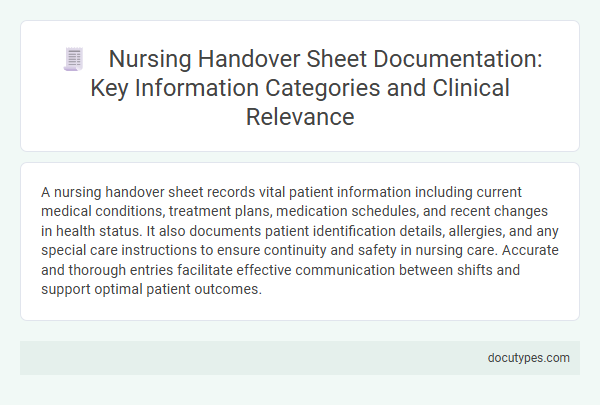A nursing handover sheet records vital patient information including current medical conditions, treatment plans, medication schedules, and recent changes in health status. It also documents patient identification details, allergies, and any special care instructions to ensure continuity and safety in nursing care. Accurate and thorough entries facilitate effective communication between shifts and support optimal patient outcomes.
Introduction to Nursing Handover Documentation
Nursing handover documentation plays a crucial role in ensuring continuity of patient care during shift changes. This process involves systematically recording vital information that supports effective communication among healthcare providers.
- Patient Identification - Essential details such as name, age, and medical record number are noted to accurately identify the patient.
- Current Medical Status - Information about the patient's diagnosis, vital signs, and ongoing treatments is documented to reflect their present condition.
- Care Instructions - Specific nursing interventions, medication schedules, and any changes in care plans are recorded to guide the next caregiver's actions.
Purpose and Importance of Handover Sheets
| Type of Information | Details | Purpose and Importance |
|---|---|---|
| Patient Identification | Name, age, sex, medical record number, room number | Ensures accurate patient tracking and prevents misidentification during care transitions |
| Medical History and Diagnosis | Primary diagnosis, comorbidities, allergies, surgical history | Provides critical context for ongoing treatment decisions and risk assessment |
| Current Treatment Plan | Medications, therapies, ongoing interventions, scheduled procedures | Maintains continuity of care and promotes adherence to prescribed regimens |
| Vital Signs and Monitoring | Recent blood pressure, temperature, heart rate, respiratory rate, oxygen saturation | Enables early detection of clinical changes requiring intervention |
| Patient Condition and Changes | Observations on patient's physical and mental status, any recent changes or complications | Facilitates timely responses and informs clinical decision-making during shift changes |
| Pending Tests and Results | Laboratory tests, imaging requests, pending and received results | Supports effective follow-up and prevents delays in diagnosis and treatment |
| Care Instructions and Precautions | Dietary restrictions, mobility limitations, infection control measures | Guides personalized patient care and enhances safety protocols |
| Contact Information | Names and roles of healthcare team members, emergency contacts | Improves communication and coordination among care providers and family members |
Patient Demographics and Identification
Patient demographics and identification are critical components recorded in a nursing handover sheet to ensure accurate and safe patient care. These details provide the foundation for continuity and clarity during shift changes, reducing the risk of errors.
- Full Name - Your patient's complete name is documented to avoid any mix-ups during transfers or treatments.
- Date of Birth - The birthdate confirms age-specific care requirements and serves as a key identifier.
- Medical Record Number - A unique identifier linked to the patient's health records, enabling precise tracking of medical history and interventions.
Current Diagnosis and Medical History
The nursing handover sheet records the patient's current diagnosis, providing precise details about the medical condition requiring treatment. It includes relevant symptoms, test results, and the stage of the illness, ensuring continuity of care. Medical history captures past illnesses, surgeries, allergies, and chronic conditions essential for informed nursing decisions.
Vital Signs and Observations
A nursing handover sheet records vital signs such as temperature, pulse rate, respiratory rate, and blood pressure to monitor the patient's current health status accurately. Observations include alertness level, pain assessment, skin condition, and any changes in symptoms or behavior noticed during the shift. This detailed information ensures continuity of care and helps identify any urgent medical needs promptly.
Medication Administration and Allergies
What types of information about medication administration are recorded in a nursing handover sheet? Details on current medications, dosages, and administration times are meticulously noted to ensure accurate patient care. This helps prevent medication errors and maintains continuity between shifts.
How are allergies documented in a nursing handover sheet? Allergies to drugs, foods, or environmental factors are clearly listed to avoid adverse reactions. Highlighting this information safeguards patient safety during treatment and medication administration.
Ongoing Treatments and Interventions
Ongoing treatments and interventions recorded in a nursing handover sheet include medication schedules, dosages, and administration routes. Details regarding wound care, intravenous therapy, and respiratory support are also documented to ensure continuity of care.
Monitoring parameters such as vital signs, pain management plans, and patient mobility interventions are noted for reference during shift changes. Your awareness of these elements helps maintain accurate and effective patient care throughout the treatment process.
Recent Clinical Events and Changes
Nursing handover sheets document vital patient information to ensure seamless care continuity. Recent clinical events and changes are critical components recorded to update incoming nursing staff about patient status.
- Recent Procedures - Details of surgeries, diagnostic tests, or treatments performed since the last handover are noted to monitor patient recovery and response.
- Vital Sign Fluctuations - Significant changes in blood pressure, heart rate, temperature, or respiratory rate are documented to detect emerging complications.
- Medication Adjustments - Any changes in drug type, dosage, or administration schedule are recorded to avoid errors and ensure proper therapeutic management.
Accurate documentation of these aspects supports effective patient monitoring and timely clinical decision-making.
Outstanding Tasks and Care Plans
Nursing handover sheets document essential information to ensure continuity of care. Outstanding tasks such as medication administration, wound care, and scheduled tests are clearly noted.
Care plans include detailed patient goals, interventions, and progress notes. These plans guide nurses in delivering personalized and effective patient care throughout each shift.
What Types of Information Are Recorded in a Nursing Handover Sheet? Infographic

